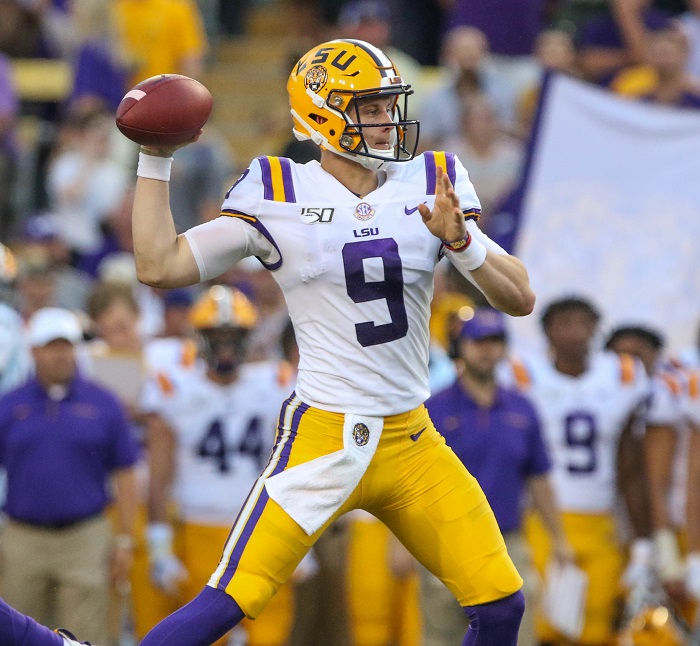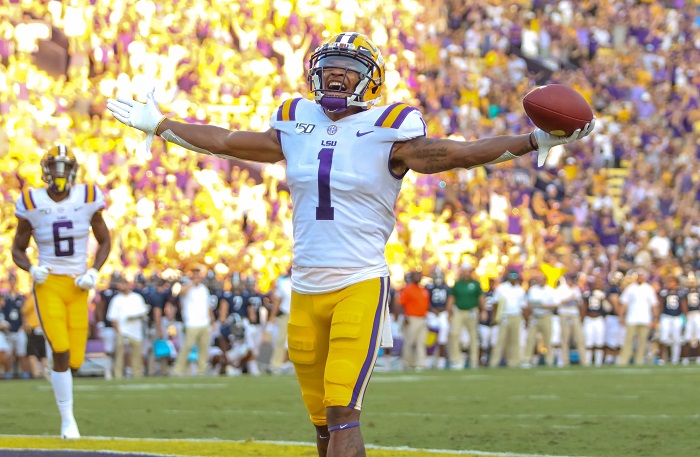
By GLENN GUILBEAU
Tiger Rag Featured Columnist
BATON ROUGE – The LSU football team was ranked No. 6 entering the 2017 season. A month later, its coach was fired, and the Tigers lost four or more games for the second time in three years. New coach Ed Orgeron finished very strong with an impressive, 29-9 win over No. 13 Louisville in the Citrus Bowl, but he still inherits a team that has not been to a major postseason game since the 2011 season.
The LSU basketball team has not won a game in more than a month as it has lost nine straight, and its coach is not likely to return for next season. The Tigers have not advanced in the NCAA Tournament since the 2008-09 season and reached just one NCAA Tournament in the last seven seasons.
But the LSU baseball team, which has reached the ultimate destination of the sport twice in the last four years and is ranked No. 2 in the nation, appears ready to get back to Omaha, Nebraska, and the College World Series, and retain its status as clearly LSU’s No. 1 athletic program of the big three.
“For me, I’ll know it’s a good year when we’re on the plane coming back from Omaha on June 27 with that trophy,” ace pitcher Alex Lange said at Media Day recently. “That’s what this culture and this talent expects, and that’s what we expect. That’s the only goal that we have.”
Multiple LSU baseball players turned down decent money and the Major League Baseball Draft after last season’s Super Regional finish to return to the Tigers.
“Omaha is why I came back,” LSU senior shortstop Kramer Robertson said. “That’s all I think about. We don’t want to talk about it too much now in January, but that’s the reason I came back, one hundred percent.”
The Tigers return eight seniors who have played significant time, which is more than in any other year under Coach Paul Mainieri, who is entering his 11th season.
Three of those seniors – Robertson, second baseman Cole Freeman and left-handed pitcher Jared Poche – are seniors and could have done well for themselves by turning pro. Greg Deichmann, a draft-eligible sophomore first baseman last year, could have as well, but he is back and in right field.
“It’s the standard of excellence that LSU holds, and we hold ourselves to it,” Deichmann said. “We try to meet that every single year.”
Mainieri thought as last season ended there was a chance he would not have any of the four – Robertson, Freeman, Poche and Deichmann – for this season.
“I’m going to call those guys my Fab Four,” he said. “Our team would have had a significantly different look to it if those four guys were not back. I still think we would’ve had a really good team. But having those four guys back just elevates your confidence in your team because of the experience, ability and leadership.”
Freeman led the team with a .329 batting average in 2016. Robertson was fourth on the team with a .324 average and was tied for third with 39 RBIs. Deichmann led the team with 11 home runs and 57 RBIs. Mainieri said he could hit 20 this season. Poche was the top pitcher with a 9-4 record and 3.35 earned run average, just ahead of Lange at 8-4 and 3.79 last season.
In all, eight starters are back, which is also a high mark for Mainieri. Sophomore Antoine Duplantis will move from right field to center field after finishing second on the team in hitting last year at .327. Junior Beau Jordan, who hit .286 with 39 RBIs last season, will return to left field, but sophomore Brennan Breaux has a chance to beat him out.
Sophomore Chris Reid started at third base last season, but at the moment he is behind freshman Josh Smith of Catholic High in Baton Rouge. Freshman Jake Slaughter of Ouachita Christian in Monroe is slated to take Deichmann’s old spot at first base. Both catchers return in junior Michael Papierski, who hit .242 in 40 starts last year, and senior Jordan Romero, who hit .297 with nine home runs and 41 RBIs in 36 starts.
“We’ve been excited about this season since Poche said he was coming back,” Robertson said. “Once we got all four of us back, there was a lot to be excited about. Once Greg announced he was coming back, I was like, ‘Man, I kind of want to come back.’ So, then I came back, and then Cole came back.”
And Mainieri’s smile kept getting wider.
“Clearly, I’ve never had four players of this impact come back,” he said. “It’s just so rare in college baseball because the best players like this are generally signing after their junior year. It’s just the nature of pro ball. We have a chance, I think, to do something special this year. We’ve got quite a veteran presence on our team.”
A NON-ALTERNATIVE FACTS LOOK AT O’S 1ST CLASS: From the “alternative” statistics department comes a factoid circulated widely after Coach Orgeron signed the consensus No. 7 or 8 recruiting class in the nation last week. This was trumpeted as the highest ranked signing class by a first-year coach in the SEC at his current school. Georgia’s Kirby Smart was second, or tied for second depending on which recruiting website that is used, with the No. 8 class last year.
Even Nick Saban’s first class at Alabama in 2007 was just No. 13. The other first-year classes that did not measure up to Orgeron’s were Gus Malzahn of Auburn with a No. 10 in 2013, Kevin Sumlin of Texas A&M with a No. 16 in 2012, Mississippi State’s Dan Mullen with a No. 20 in 2009, Florida’s Jim McElwain with a No. 21 in 2015, Arkansas’ Bret Bielema with a No. 23 in 2013, Tennessee’s Butch Jones with a No. 24 in 2013, South Carolina’s Will Muschamp with a No. 25 in 2016, Kentucky’s Mark Stoops with a No. 34 in 2013, Missouri’s Barry Odom with a No. 43 in 2016, Vanderbilt’s Derek Mason with a No. 46 in 2014 and Ole Miss’ Hugh Freeze with a No. 47 in 2012.
That statistic is not alternative. It is true. But it is also misleading.
Of the 13 coaches listed above who are not Orgeron, none was named interim coach during the season before they took over for their first full season. Not only was Orgeron named interim coach last season, that happened extremely early compared to most coaching changes in which someone on the staff is promoted to head coach. He took over for the fired Les Miles on Sept. 25, before getting the permanent position on Nov. 26, two days after the regular season.
The hiring of Smart, for example, by Georgia did not happen until Dec. 7, and he did not become Georgia’s full time coach until Jan. 12 as he finished the 2015 season as defensive coordinator at Alabama, which won the national championship that season. Of the above 13 coaches other than Orgeron, only Missouri’s Barry Odom was already on the staff on which he became head coach. Missouri promoted him from defensive coordinator to head coach on Dec. 3, 2015, after he had served that season on Gary Pinkel’s staff. The other 12 non-LSU coaches came in fresh in late November, December or January. That makes it a little more difficult to recruit, to say the least. And since Orgeron got on board so early, that helped LSU keep recruits that may have drifted had Miles remained later into the season.
Saban did not start working at Alabama until Jan. 4, 2007, with signing day just over a month away on Feb. 7. Mason did not start working at Vanderbilt until Jan. 17, 2014, with signing day less than three weeks away on Feb. 5.
Now, Orgeron and his staff and the recruits they were going after – or in most cases trying to keep – did not know he was going to be the permanent coach until late November, but still Orgeron being the interim coach for two solid months no doubt helped with continuity. Orgeron was also on staff at LSU before being named coach longer than the other 13. He was named defensive line coach on January 14, 2015, and quickly became very involved in recruiting. He was then named recruiting coordinator a year later when Frank Wilson left. So Orgeron moved to head coach in much more seamless fashion than the other SEC coaches. That helps in recruiting.
It should also be noted that when Orgeron took over for Miles on Sept. 25, 2016, LSU’s class was a consensus No. 7 in the nation and already had 19 commitments. It’s not like he had to assume a hurried, damage control position. Things were going pretty well. He had to deal with some negative recruiting, but not as much as he would have had he taken over later. Orgeron had a lot to do with how good that class was already, but Miles deserves much credit for LSU’s class of 2017 as well. Orgeron did a very good job keeping most of that class intact. He lost a few. He gained a few. But in the end, he started with 19 and finished with 23. Is that great? A No. 7 or No. 8 class is very good. It’s not great.
QUOTE OF THE YEAR … AGAIN AND AGAIN: “We needed to raise ticket prices to balance the budget for the season coming up. With our setup costs (about $2 million) and the UNCERTAINTY of the network, if we didn’t raise ticket prices we wouldn’t have been able to balance the budget for this year, even with the network. My hope is over time, the funds we get from the network will significantly reduce the need to raise ticket prices in the future. I’m not saying we won’t raise ticket prices, but hopefully not as much.”
—LSU athletic director Joe Alleva speaking at the Baton Rouge Press Club luncheon on May 12, 2014, not long after significantly raising football ticket prices just before the SEC Network dawned on Aug. 14, 2014.
NOTE ON THE QUOTE OF THE YEAR … AGAIN AND AGAIN: If Alleva didn’t raise ticket prices then, he wouldn’t have been able to concoct much of an argument for a hike any time soon (other than for paying off a former football coach’s huge and unwarranted, $9 million buyout) without being laughed at, considering the millions upon millions of dollars the SEC has profited from the SEC Network. On Friday, the SEC announced a record $40.4 million revenue distribution for the 2015-16 fiscal year to the 14 league schools, which is double what the 14 got in 2014 BEFORE the SEC Network. In the 2014-15 fiscal year, SEC schools got $32.7 million after getting $20.9 million in 2013-14 before the SEC Network. Even before the SEC Network began, most experts saw it differently than Alleva. They were CERTAIN it would make a lot of money.




Be the first to comment